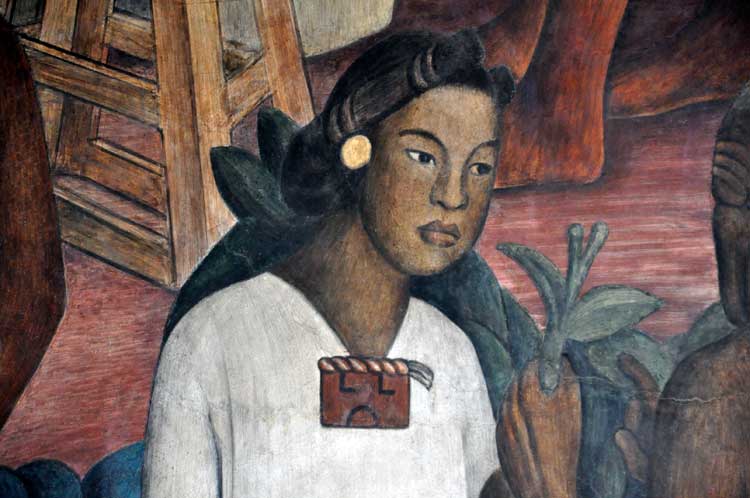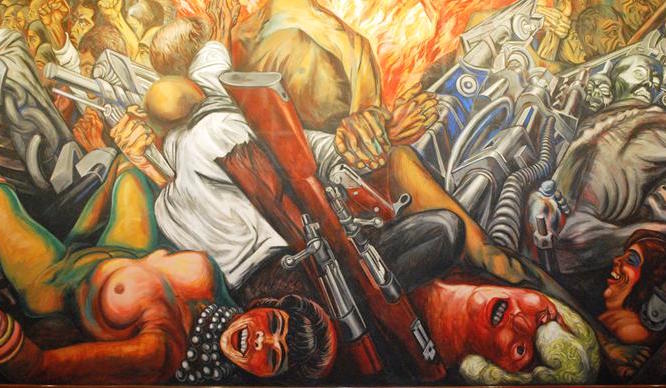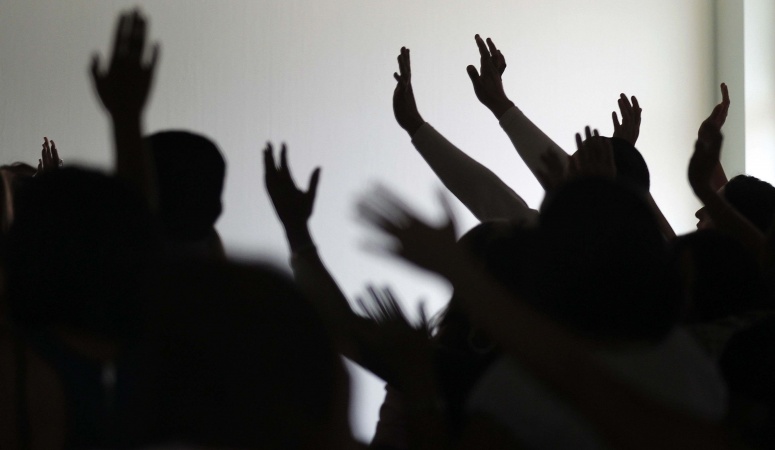From time to time Religious Theory (RT) invites well-known academic authors to outline current book projects that have not yet been published. This second installment of the article, released in three parts, reflects a recent talk in California by Prof. Luis Leon, a well-known author of several key books on the theory of Latino religions and borderlands theory.
Central to the project on “spiritual erotics” I outlined last week is the problem of machismo.
Latino men, despite their countries of origin, are subjected to personal and public valuations of their masculinities using the characteristic negative stereotypes of machismo. These assessments not only hurt Latino men, but at once impugn Latina women as enablers of what have been called the “machista vices.”[1] Racialization of Latina/o communities is inextricably tied to discourses of machismo. “Machismo” is simply translated as “maleness,” but it has come to signify a cult of extreme virility, staged upon a stark gender duality. Latino men’s behaviors are publicly regulated and policed according to standards set by common behavioral codes originating in colonial religious systems.
Machismo is defined by many insiders as the masculine practice of shutting down one’s emotional and physical affects. Ilan Stavans describes his indoctrination into Mexican manhood: “To be a Hispanic man was to hide one’s emotions, to keep silent when it came to expressing your heart. We are supposed to swallow our pain and never cry como una nina—like girls. Keep a straight face, suck it up—se muy mucho.”[2]
The condition of Latino maleness is produced by a racial discourse. Stavans was taught to be a Hispanic man, not just a man, not just a Mexican, not just a human. Yet, Stavans’ own account testifies to the way he himself was conditioned to transgress macho norms: “My father taught me to show affection in public. When departing, he would kiss me without inhibition.”[3] His accounting for his own gender socialization creates a tension between the discursive myths and actual practices of Latino masculine formation.
This tension was explored also by the Mexican Nobel Prize-winning author Octavio Paz (1914-1998) in his The Labyrinth of Solitude published in 1961. Writing on machismo, Paz claimed that Mexican men could maintain their macho identity even when engaging in homosexual encounters if they opened up another man: “Masculine homosexuality is tolerated, then, on condition that it consists in violating a passive agent….the important thing is not to open oneself up and at the same time to break open one’s opponent.”[4] The distinction between an open and closed subject is not only figurative, but literal.
Rudolfo Anaya describes the macho mandate of shutting down as the ethic of aguantar, or holding it in, closing off one’s emotions: “The macho does not cry in front of men. A macho does not show weakness. Grit your teeth, take the pain, bear it alone. Be tough.”[5] The ethic of closing down, or aguantar, is performed in opposition to what Stavans has iterated as “’the shameful art of abrirse’—opening up and losing control.”[6]
The first macho proscription bans male tears. Weeping is a macho taboo because it marks men as open, exhibiting weakness and vulnerability. Pentecostal initiation requires opening oneself up to receive the Holy Spirit, a moment marked by tears of joy and ecstasy, as is all subsequent spiritual intercourse; when affected, Latino men can transgress macho boundaries.
Some academic writing on gender systems in Latin America too often reifies machismo, leveling complex gender systems to a uni-dimensional macho monolith that is sometimes crossed, but never de-stabalized. One anthropologist has proposed: “Loyalty to and credence in the ideal norms are considerable. They are constantly reiterated in many media, especially in primary socialization. The machismo complex may not be a sui generis reality, but belief in and approval of it channel behavior to conformity.”[7]
The anthropologist Roger Lancaster writes: “machismo is ‘more than an “effect’’ produced by other material relations. It has its own materiality, its own power to produce effects,…its own economy.”[8] Certainly machismo emerges form within a distinct social ecology, but reifying it in these ways ignores its complex colonial history, multiple manifestations and everyday transgressions.
No one denies that patriarchy and oppression of women are tragic realities. However, this is not a discreet Latino pathology. Instead, Ana Castillo and others understand machismo as a legacy of colonialism, particularly Christian and Muslim misogyny. She writes: “It is of utmost importance to understand the damage that machismo has done and continues to do to humankind in the name of tradition and in the name of much that we hold sacred through institutional religion. We must recognize that certain behavior that has been accepted by our culture and sanctified by the church is not innate. Men are not born macho, they are made macho.”[9] Like Castillo, my work frames the problem of machismo as a religious issue.
The macho is the male counterpart to Marianismo, or the Latin American devotion to the Virgin Mary in a multiplicity of iterations. In Mexico The Virgin of Guadalupe reigns supreme. She signifies mythical virgin motherhood, inspiring the discourse of hembrismo, or femaleness. Her narrative activates the macho—especially in as much as women are destined to emulate the Catholic feminine ideal by embodying virgin motherhood: a discourse of marianismo.
An Iberian religious inheritance has shaped gendered behavioral codes in Latin America, pivoting on the holy couplet of Marianismo (Marianism)/machismo. Machismo would not be possible without the long-suffering, demure, sacred figure of the virgin mother who, according to the anthropological mythology, enables machista attitudes and behaviors. Hence, machismo is a key element in a religious script defining gender codes. In other words, machismo is a myth. This work will critically explore the mythological dimensions of the macho.
The rise of Pentecostalism across the Latina/o Americas has spawned studies arguing that evangelical conversion provides the antidote to what has been deemed “machista vices.” The sociologist Bernice Martin argues: “curbing the typical vices of the ‘machista’ culture of the men in the streets and bars, notably drink, drugs and ‘whoring.’ Indeed, it would not be an overstatement to claim that an indispensable part of the appeal of Pentecostalism is its ability to save the men from ‘machismo’ and put the family back together as an effective unit of economic co-operation as well as of stable relationships.”[9]
Certainly Pentecostalism’s prohibition of alcohol can reform dysfunctional male drunkenness where it exists, which, unlike Martin’s suggestion, is not universal. Describing alcoholism, drug addiction and frequenting of “whores” as “typical” macho behavior perpetuates racial stereotypes, generalizing and pathologizing Latina/o families. More nuance is required in academic discussions of machismo.
Similarly, in 1995, the anthropologist Elizabeth Brusco published a book entitled The Reformation of Machismo: Evangelical Conversion and Gender in Columbia.[11] Like Martin, she found that Latin American women convert to Pentecostalism at much higher rates than do men. Brusco argues that Pentecostalism reinforces what she calls the “undeniable” gendered reality of entrenched cultural values, but empowers women by elevating “domesticity.” Pentecostal conversion “reattaches males to the family….it glorifies and supports what is female.”[12]
In fact, “the theme of male domestic abdication” grounds her study.[13] Her ethnography of Columbian Pentecostals waxes broadly on all Latinos, and her analysis affirms and advances the social scientific and psychological literature on machismo as cultural and individual pathology: “machismo is best applied to the pattern emerging from male self-doubt.” [14]
As a self-described “feminist,” Brusco focuses on women’s roles, reviewing the literature on machismo, she stresses the active role of Latinas as agents of their own oppression. “The female counterpart to machismo, marianismo, is in every way machismo’s mirror image. Arrogance and intransigence in the male are mirrored by self-abnegation and submission in the female. A double standard of extreme proportions awards all the spoils to men and reduces women to little more than domestic slaves.”[15]
Brusco distinguishes between what she calls, the “confident true macho,” associated with strength and other positive characteristics, and machismo, who she describes as the typical wife-beating, alcoholic, drug-addicted, hyper-sexual adulterer. Yet, she dismisses the “confident” or positive macho by arguing that those characteristics are better described by other anthropological categories.
There is no doubt that domestic abuse occurs in Latino households. The question, however, is the extent to which those behaviors are accepted as the cultural norm and celebrated as the cult of machismo.
At least one anthropologist has found that these stereotypes belong to a social-science Orientalizing discourse, and that they are not native to the way Latin American men see themselves. Matthew Guttman’s study of family and masculinity in Mexico challenges and disrupts racializing ethnographic narratives: The Meanings of Machismo: Being a Man in Mexico City [16]. In the book he documents the way Mexican men see themselves, parent their children, relate to women, and talk about sex. His findings are consistent with those of Alfredo Mirande, in his study, Hombres y Machos: Masculinity and Latino Culture, who found that Latino men articulated a definition of machismo in which men adhere to a “code of honor,” valuing strength while respecting women, their families, and each other.
Similarly my work challenges stereotypical understandings of machismo by framing it as a complex religious problem, one that has a mythological component to it. The value of masculine identity is set within a human economy of performance and symbolic exchange; performance enables accumulation, and consumption or expenditure of emblematic capital. Hence, men negotiate their masculinity—the more masculine hetero-normative capital they acquire, the more they can spend. In this way, men who have banked stores of macho heterosexuality can then exchange it to allow for homo social, erotic, and affective behaviors while still maintaining the lion’s share. The men in my study converted while they were single. Thus their narratives challenge the notion that men require women for their conversion. On the contrary, the men I study were each converted by other men, affected; their conversions created homo social bonds.
Pentecostalism is contagious. There is a clear line of transmission among the men in my study, from Nicki Cruz to Sonny Arguinzoni to Art Blajos to the men in the pews at Alcance Victoria. My work asks about the costs Pentecostal women pay for participation in a Christian patriarchal family wherein biblical fundamentalism requires women to submit to their husbands. In the writings of Julie Arguinzoni, Sonny’s wife, she claims to have become so unhappy submitting to her husband and his ministry that she began to pray for her own death[17]
Gender lines in Pentecostal churches tend to be tightly drawn, with women and man forming their own sodalities. Through these narratives I explore these affective homosocial bonds, the virality of Pentecostalism, masculinity, machismo (opening up and shutting down), and these men’s relationship to women compared to how such relationships are characterized in racializing discourses.
Luis Leon is Professor of Religious Studies at the University of Denver. He is the author of La Llorana’s Children: Religion, Life, and Death, in the U.S.-Mexican Borderlands (University of California Press, 2004) and The Political Spirituality of Cesar Chavez: Crossing Religious Borders (University of California Press, 2014).
___________________________________________________________________________________
[1] See Bernice Martin, “New Mutations of the Protestant Ethic among Latin American Pentecostals,” in Religion, 25 (1995): 101-117.
[2] Ilan Stavans, “The Latin Phallus,” in Ray González, ed., Muy Macho: Latino Men Confront Their Manhood (NY: Anchor Books, 1996), 153.
[3] Ibid., 153.
[4] Octavio Paz, The Labyrinth of Solitude (NY: Grove Press, 1961) 40.
[5] Rudolfo Anaya, “I’m the King: The Macho Image,” in González, ed, Muy Macho, 1996), 63.
[6] Stavans, The Latin Phallus, 148.
[7] Stephen O. Murray, Latin American Male Homosexualities (Albuquerque: University of New Mexico Press, 1995) 64.
[8] Roger N. Lancaster, Life is Hard: Machismo, Danger, and the Intimacy of Power in Nicaragua (Berkeley: University of California Press, 1992), 236.
[9] Ana Castillo, “Ancient Roots of Machismo,” in Massacre of the Dreamers: Essays on Xicanisma (NY: Plume Books, 1995), 87.
10] Martin, “New Mutations of the Protestant Ethic among Latin American Pentecostals,”110.
[11] Elizabeth Brusco, The Reformation of Machismo: Evangelical Conversion and Gender in Columbia (Austin: University of Texas Press, 1995).
[12] Ibid., 3.
[13] Ibid, 79.
[14] Ibid., 79.
[15] Ibid., 79, emphasis added.
[16] The Meanings of Machismo: Being a Man in Mexico City (Berkeley: University of California Press, 2006.
[17] See Sonny and Julie Arguinzoni, Treasures Out of Darkness (Kingsway Publications, 1992).




